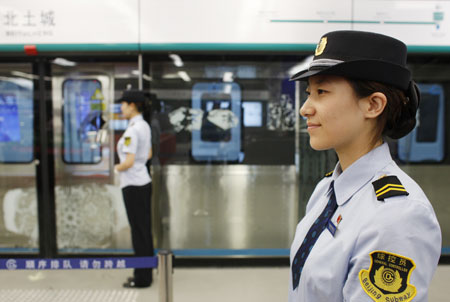 |
|
Beijing subway controllers stand on a subway platform inside a new station near the Olympic Stadium during a media tour in Beijing July 19, 2008. Beijing opened two new subway lines and an airport rail express on Saturday ahead of the Olympic Games. [Agencies]
|
BEIJING -- After finishing Olympic venue construction projects either on time or ahead of schedule, Beijing honored its commitment of ensuring smooth traffic by opening three new metro lines on Saturday.
An opening ceremony was held at Beitucheng Station, the transfer station of Line 10 and the Olympic Branch Line, on Saturday morning. Journalists and a limited number of residents with intra-day tickets witnessed the scene. The other line opened was the Airport Line.
"The opening of three new lines indicates that Beijing is ready to embrace the passenger surge during the Olympic Games," said Liu Xiaoming, head of Beijing's traffic commission.
The three lines began carrying passengers from 2 pm.
The new links, built at a total cost of 22.3 billion yuan ($3.2 billion), increased the number of metro lines in the Chinese capital to eight and the total length of track to 200 kilometers from the current 142 km.
The entrance of Beitucheng Station is in the shape of a Chinese porcelain vase. Walking through the vase and stepping down to the platform, visitors saw two rows of porcelain pillars standing on both sides.
Turkish journalist Osman Erol said he was attracted by the theme of Chinese porcelain in the station's decoration.
At Olympic Forest Park Station on the Olympic Branch Line, people marveled at the steel grid ceiling over the platform, which resembled the structure of the Bird's Nest on the ground right above the station.
Different elements, mostly from Chinese traditional culture, were absorbed by architects to decorate the 30 stations along the new lines.
Running on the lines were new trains made from high-strength stainless steel and with four automatic doors on every carriages. There is an emergency door in every carriage.
Outside every station on the Olympic Branch Line, there are blue bulletin boards showing the location of nearby bus stations and all major bus routes.
Faster and Safer Services
Zhou Zhengyu, Beijing Municipal Committee of Communications deputy head, said trains would be running at an average interval of 3.5 minutes on Line 10.
The average interval on the Airport Line, which links the downtown areas with Terminal 3, a new terminal building at the Beijing Capital International Airport in the northeastern suburbs, will be 15 minutes. The 28-km trip would take about 20 minutes, he added.
Beijing traffic authorities were working on a metro line operation schedule for passengers shuttling between different Olympic venues, according to Zhou.
Beginning on Sunday, vehicles with even and odd number plates will have to run on alternate days on Beijing's roads, and an additional 4 million people are expected to resort to the public transport system.
The trains used for the new lines can carry 1,424 passengers each, or 344 more than those on other lines, said Zhou.
A public hearing early this month by the National Development and Reform Commission decided a reasonable fare for a subway ride to the airport should be around 25 yuan ($3.6).
Beijing subway operators have estimated a daily maximum of 30,000 passenger trips on the Airport Line during the August 8-24 Olympic Games, according to Liu Jian, deputy head of Beijing Mass Transit Railway Operation Corp Ltd.
Metro builders have set aside room in the Dongzhimen Railway Station, the downtown end of the Airport Line, where in the future, passengers will be able to check in for their flights and have their luggage delivered.
But no timetable is immediately available as to when the check-in counters will be set up at the downtown metro station.
The Olympic Branch Line, running 4.5 kilometers, will carry spectators to the main Games' venues in northern Beijing, and Line No. 10 will run 25 km northwest to southeast in the shape of a right angle.
But before and during the Games, the Olympic Branch Line will open exclusively to participants to the Games, including athletes, coaches, journalists and others, and spectators holding tickets for the day, said Zhou.
"The passengers all need to receive security checks on the ground before they take the Olympic metro to the Games' facilities," he said.
Besides the new metro lines, 34 Olympic bus routes will help carry passengers to all the venues, said the city traffic commission head.
Meanwhile, local authorities have marked out special lanes for Olympic vehicles on the second, fourth and fifth ring roads to ensure smooth traffic, he added.
He said about 2,000 new buses would be put into use during the Games, which would increase the city's bus transport capacity to about 15 million people per day.
Some 66,000 taxies, being maintained properly and ordered to avoid running without passengers, would be able to carry up to 2.45 million people every day.
In addition, there would be an one-hour ferry bus service around each of the 23 venues after the conventional routes stopped operating at night.
"With all the measures and people's support, we are confident of ensuring smooth traffic during the Games." he said.

